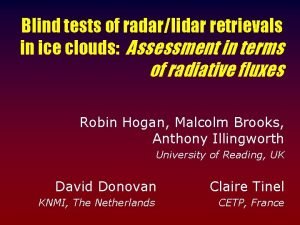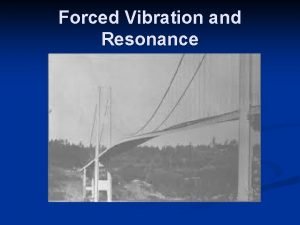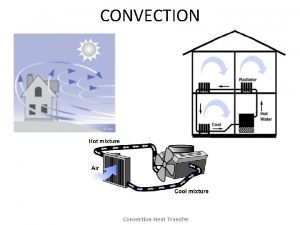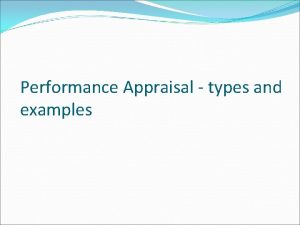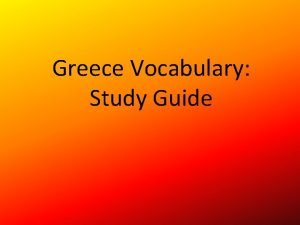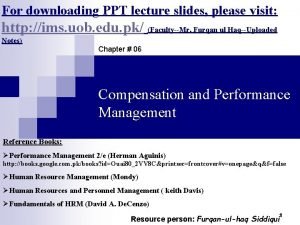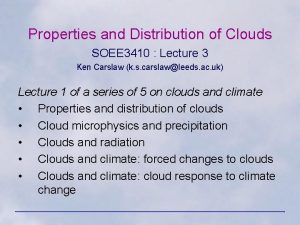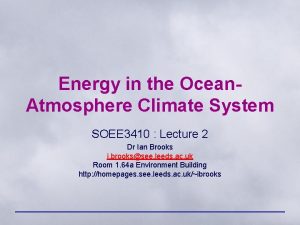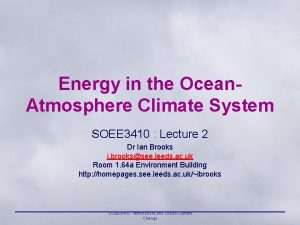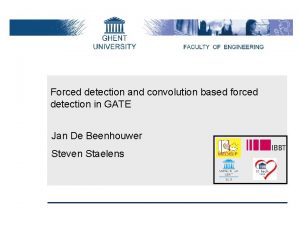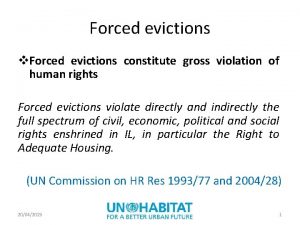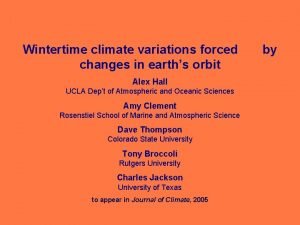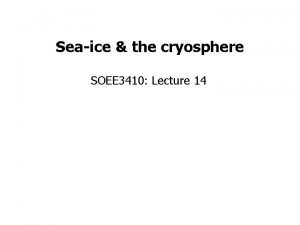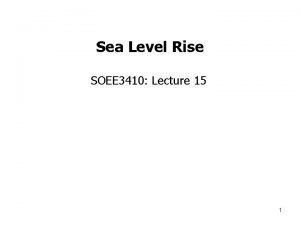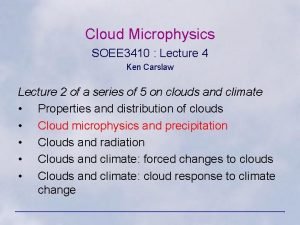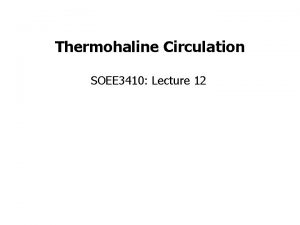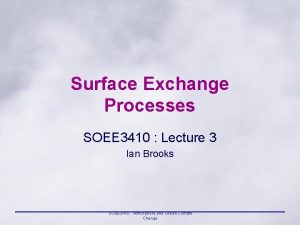Clouds and Climate Forced Changes to Clouds SOEE
























- Slides: 24

Clouds and Climate: Forced Changes to Clouds SOEE 3410 Ken Carslaw Lecture 4 of a series of 5 on clouds and climate • Properties and distribution of clouds • Cloud microphysics and precipitation • Clouds and radiation • Clouds and climate: forced changes to clouds • Clouds and climate: cloud response to climate change

Content of Lecture 8 • Forcing mechanisms through aerosol-cloud interactions • Observational evidence for changes in clouds • Climate models and estimated radiative forcings ENVI 3410 : Coupled Ocean & Atmosphere Climate Dynamics 1

Reading • Global indirect aerosol effects: a review, U. Lohmann, J. Feichter, Atmospheric Chemistry and Physics, 5, 715 -737, 2005. Available online at http: //www. copernicus. org/EGU/acp/5/715/acp-5715. htm • The complex interaction of aerosols and clouds, H. Graf, Science, 303, 1309 -1311, 27 February 2004. ENVI 3410 : Coupled Ocean & Atmosphere Climate Dynamics 1

Changes to Clouds Forced by Aerosol. . . unperturbed cloud Increased CDN (constant LWC) Albedo effect Twomey effect 1 st Indirect effect Drizzle suppression (increased LWC) Increased cloud height Increased cloud lifetime Cloud lifetime effect Albrecht effect 2 nd Indirect effect ENVI 3410 : Coupled Ocean & Atmosphere Climate Dynamics . Heating increases cloud burnoff Semi-direct effect 1

An Additional Forced Change • Not yet considered by IPCC Cumulonimbus Change in ice formation, latent heating See the Graf paper liquid ENVI 3410 : Coupled Ocean & Atmosphere Climate Dynamics 1

Cloud Drop Number and Aerosol • Composite of observations from many measurement sites ENVI 3410 : Coupled Ocean & Atmosphere Climate Dynamics 1

An Example of CDN-Aerosol Relationship CDN (cm-3) Observational data from Gultepe and Isaac (1999) • Why doesn’t CDN increase linearly with aerosol number? Aerosol Number (cm-3) ENVI 3410 : Coupled Ocean & Atmosphere Climate Dynamics 1

Aerosol • Calculate cloud drop number based on a fixed updraught speed CDN Explanation for CDN-Aerosol Relationship Why doesn’t CDN increase linearly with aerosol number? • Maximum supersaturation (Smax) in cloud is reduced by droplet growth • Figures show global model calculations Smax ENVI 3410 : Coupled Ocean & Atmosphere Climate Dynamics 1

Other Factors Affecting CDN • Updraught speed – Very difficult to quantify at global model spatial resolutions • Aerosol size distribution – Typically not simulated in a global model • Aerosol composition – Mass of main components (sulphate, organics, salt etc) ENVI 3410 : Coupled Ocean & Atmosphere Climate Dynamics 1

How aerosol size affects CDN • Model calculations ENVI 3410 : Coupled Ocean & Atmosphere Climate Dynamics 1

Droplet number vs. aerosol size and number • Fixed updraught speed log(N) Solid contours = CDN; colours = aerosol mass (mg m-3) ENVI 3410 : Coupled Ocean & Atmosphere Climate Dynamics Diameter 1

Satellite Observations • Polder satellite • POLarization and Directionality of the Earth's Reflectances radiometer • TOP: Aerosol index (measure of aerosol column number) • BOTTOM: Cloud droplet radius • Breon et al. , (Science, 2002) ENVI 3410 : Coupled Ocean & Atmosphere Climate Dynamics 1

Satellite Observations of 1 st Indirect Effect • Polder Satellite data • Cloud drop radius decreases with increasing aerosol number A rough measure of aerosol number concentration Bréon et al. , Science 2002 Quaas et al. , JGR 2004 ENVI 3410 : Coupled Ocean & Atmosphere Climate Dynamics 1

Cloud drop radius (mm) Oceanic vs. Continental Regions Ocean Aerosol Optical Depth Ocean cloud drop radius Land cloud drop radiuys Aerosol index • Ocean clouds are more susceptible to changes in aerosol than over land • Oceans also have lower albedo (larger change in reflectivity) ENVI 3410 : Coupled Ocean & Atmosphere Climate Dynamics 1

Localised Effects • Aerosol point sources in the Adelaide region of Australia • Advanced Very High Resolution Radiometer (AVHRR) multi-wavelength satellite observations • Green/yellow implies smaller/more numerous drops in polluted regions ENVI 3410 : Coupled Ocean & Atmosphere Climate Dynamics 1

Inferred Changes in Precipitation 5 3 2 1 Approx altitude (km) 4 • Collision and coalescence suppressed in polluted deep convective clouds • Refer to Lecture 2 polluted clouds From Ramanathan et al. , Science, 2001 clean clouds ENVI 3410 : Coupled Ocean & Atmosphere Climate Dynamics 1

The Semi-Direct Effect Cloud Fraction Koren et al. (2004): observational evidence for semi-direct effect based on MODIS satellite Smoke Optical Depth Columbia Shuttle image MEIDEX, January 12, 2003 ENVI 3410 : Coupled Ocean & Atmosphere Climate Dynamics 1

Treatment of CDN in Climate Models • Single fit equations describing CDN vs. model aerosol number Jones (1994) (Met Office Model) Global Gultepe and Isaac (2004) Continental Marine ENVI 3410 : Coupled Ocean & Atmosphere Climate Dynamics 1

Model Calculations of CDN 1860 emissions 2000 emissions ENVI 3410 : Coupled Ocean & Atmosphere Climate Dynamics 1

Model Calculations of Change in Surface SW Energy Budget • Due to aerosol direct effect and 1 st/2 nd indirect effects • Cloud effects significant ENVI 3410 : Coupled Ocean & Atmosphere Climate Dynamics 1

Global Mean Forcings From Intergovernmental Panel on Climate Change Scientific Assessment ENVI 3410 : Coupled Ocean & Atmosphere Climate Dynamics 1

Uncertainties (1/2) • Observations – Limited quantitative information from satellites • Aerosol and cloud drop optical properties (no aerosol chemistry, no direct microphysics measurement) • Cloud top only – Difficult to determine cause and effect • What would clouds look like without increased aerosol? – Multiple changes • No “control experiment” • Increased aerosol loading is often associated with drier air • 1 st indirect effect never observed without other changes – ENVI 3410 : Coupled Ocean & Atmosphere Climate Dynamics 1

Uncertainties (2/2) • Models – Aerosol schemes too simplistic • Particle size/composition – Cloud physics incomplete • Highly parameterized • CDN-aerosol link too simplistic (improvement needs information that is unreliable in models; e. g. , updraught speed) • Rain formation – Sub-grid processes (multi-cell clouds) – Aerosol is short-lived and transported/removed according to complex weather patterns ENVI 3410 : Coupled Ocean & Atmosphere Climate Dynamics 1

Questions for this lecture • Explain why cloud drop number concentration doesn’t increase linearly with aerosol number concentration • On slide 15, explain why the radiative properties of the clouds change in the yellow regions. Construct your argument based on constant LWC. • Why might LWC not be the same in the yellow and pink regions (clue in slide 16) • Why are marine clouds more “susceptible” to changes in cloud drops than continental clouds? • On slide 19, why is the map of changes in cloud drop number so patchy? Hence explain why the aerosol indirect effect is hard to predict in models. ENVI 3410 : Coupled Ocean & Atmosphere Climate Dynamics 1
 Graf soee
Graf soee Soee test
Soee test Elizabeth mulroney
Elizabeth mulroney What is chemical change
What is chemical change Climate change 2014 mitigation of climate change
Climate change 2014 mitigation of climate change Forced vibration and resonance
Forced vibration and resonance Characteristic length
Characteristic length Forced vibration and resonance
Forced vibration and resonance Natural response and forced response
Natural response and forced response Natural response circuit
Natural response circuit What is forced choice questions
What is forced choice questions Teknologi tenaga perlis consortium sdn bhd
Teknologi tenaga perlis consortium sdn bhd Ranking method of performance appraisal example
Ranking method of performance appraisal example What is a passive movement
What is a passive movement What was the inscription on the iron door of auschwitz
What was the inscription on the iron door of auschwitz Diaphragm attachments
Diaphragm attachments Front-end innovation methodology
Front-end innovation methodology Scr family
Scr family Forced sterilization
Forced sterilization Messenian person forced to work as a lowly farmer by sparta
Messenian person forced to work as a lowly farmer by sparta Indigenous name for forced labour
Indigenous name for forced labour Forced association
Forced association Performance management ppt
Performance management ppt Oil natural air forced
Oil natural air forced I've gotten better
I've gotten better

